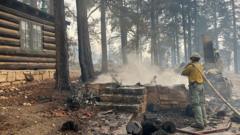A significant wildfire in the Grand Canyon region has led to the destruction of multiple structures, including the iconic Grand Canyon Lodge, the sole accommodation previously available at the North Rim of the national park. The raging inferno, known as the Dragon Bravo Fire, in tandem with another blaze, the White Sage Fire, has engulfed vast swathes of land, prompting the closure of the North Rim for the entirety of the 2025 tourist season.
The Dragon Bravo Fire ignited on July 4, allegedly due to a lightning strike. Shortly afterward, the White Sage Fire was reported following a thunderstorm that swept through the area. As of the latest reports, both fires remain completely uncontained and are posing significant challenges for firefighting efforts.
The Grand Canyon Lodge, which has been a key establishment since the 1930s, offered dining, retail options, and a post office. Aramark, the corporation that managed the lodge, expressed its devastation over the loss, thanking both firefighters and employees for their safety amidst the chaos.
Despite the extensive damage, there have reportedly been no casualties linked to the fires. However, initial assessments from the National Park Service indicate that upwards of 80 buildings have been destroyed, including visitor centers and administrative offices. Compounding the firefighting efforts, personnel were forced to evacuate at various locations due to a chlorine leak from a nearby water treatment facility, creating an additional hazard.
Arizona's Governor Katie Hobbs has publicly called for a thorough investigation into the federal government's management of the fires, positing that the decision to conduct controlled burns amid the sweltering heat of summer contributed to the wildfire outbreak. The Interior Department’s spokesperson refuted claims of mismanagement, insisting that federal fire experts are acutely aware of wildfire risks.
As the White Sage Fire continues to threaten the Kaibab National Forest, impacting hundreds of residents, attention remains on the Grand Canyon National Park, which is typically a hotspot for tourism, drawing nearly five million visitors in 2024. The South Rim of the canyon remains accessible to the public, despite these catastrophic events.























